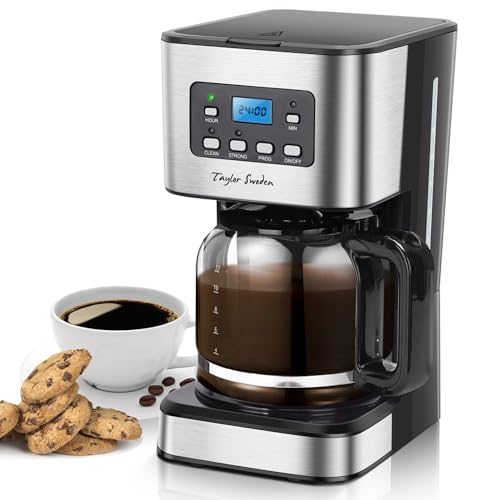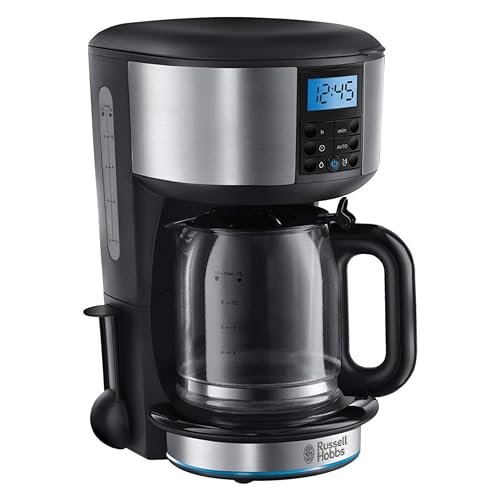Where Will Coffee Filter Machine Be One Year From This Year?
페이지 정보

본문
 The Importance of a Coffee Filter Machine
The Importance of a Coffee Filter MachineIt is best to use clean, fresh filtered water to achieve the best results. This allows the complex flavors of coffee beans to shine through.
You will also save money over the long-term by using a filter drip machine, coffee filter maker as you only have to purchase paper filters and coffee ground. You may also find you save money on cleaning and disposal costs.
Filtered Water
Many coffee and espresso machines come with their filtering system. Some use reusable filters, like everyone's favorite, the Brita. Clean water is the primary ingredient to make the perfect cup. Aside from the obvious health benefits, drinking water that is filtered enhances the taste and consistency of your beverage.
The process of filtration involves pushing water through a filter composed of tightly woven papers or mesh that is either bleached or not bleached. Unbleached filters do not make use of chemicals, but are bleached with chlorine or oxygen to get their white color. Some people prefer the flavor of a bleached filter while others find the coffee more sour or less flavorful.
There are also permanent coffee filter systems on the market including perforated metal sheets and fine plastic mesh porous ceramics, and glazed porcelain sieves that contain the grounds but allow water to flow through. They might need to be heated or rinsed regularly to function, but are cheaper and less wasteful.
Filtered water is also a good choice with pour-over and French press methods, as it gets rid of some of the coffee oils that can affect the final cup. These oils are essential to the flavor and aroma of the beverage. Eliminating them can make an important difference. Additionally filtering, it makes sure that all the ground coffee is properly brewed and does not leave any granules behind.
It is important to choose an appropriate filter that is compatible with your brewing method to ensure the optimal results. For example, the Aeropress uses a specific size of paper filter that is designed to reduce the amount of coffee oil and sludge in the final product. It is essential to wash your filter with soapy, hot water prior to every use. This will eliminate any flavor of paper that might remain and stop it from tainting coffee. Some people have found that using a conical coffee filter produces a richer, more consistent brew than using a flat filter. This is due to the fact that the conical filter allows the water to flow through the grounds evenly by following the gravity.
Temperature and Pressure
The temperature of the water in a filter machine is vital. In addition to allowing the correct water-to-coffee ratio, it also ensures the best extraction of flavours and aromas. The ideal temperature for brewing is 88degC-92degC. Some machines have built-in water thermometers that permit you to check the temperature of the beer. Other gadgets such as gooseneck kettles and laser thermometers are also able to assist you in achieving the ideal brewing temperature.
The filter of a coffee filter machine's paper is also essential. The most commonly used are paper filters, but there is a growing market for reusable filter sieves. They are made from materials like metals woven into a weave, such as steel, aluminium, and copper, plastics (including Makrolon/Exolon and Tritan), porous ceramics or porcelain, and can be inserted in filter holders designed for paper or cloth filters.
The filters are available in a wide assortment of shapes and sizes. Some of them have a distinct "paperish" taste, which can be diminished by cleaning the filter with hot water prior use. Permeability can also have a major impact on the final flavor of the coffee. This is influenced by the shape and size of the filter drip coffee, the material used to create it, as well as the manufacturing process.
Regularly cleaning your filter coffee maker is important particularly when you live in a region with hard water. This will ensure that the machine is working effectively and will avoid mineral deposits. Regular cleaning routines should include emptying the grounds used and washing the filter basket.
Numerous studies have looked into the effects of varying the temperature of the brew on total dissolved (TDS) and extraction quality. The results suggest that a poor extractive quality and high TDS can lead to unpleasant sensory characteristics like bitterness, astringency, or the sourness. However, the results of these studies do not compare the taste of coffee served at controlled serving temperatures and, therefore, cannot determine whether the sourness that is observed is due to the higher TDS or a lower quality extract. The astringency or bitterness that was observed in these studies could also be due to other factors, such as the grind size of the coffee or the roasting process.
Extraction
During the brewing procedure water extracts flavors and oils that give the desired taste to a cup of coffee. This extraction is a highly variable process that is affected by a variety of factors, including the water temperature, brew time, and the kind of filter used.
 The process of wetting the coffee filter prior to the brewing process plays a crucial part in enhancing the flavor of coffee. It enhances the flavor of the coffee by promoting an even extraction of grounds, and also reduces bitterness through minimizing over-extraction.
The process of wetting the coffee filter prior to the brewing process plays a crucial part in enhancing the flavor of coffee. It enhances the flavor of the coffee by promoting an even extraction of grounds, and also reduces bitterness through minimizing over-extraction.Pre-wetting the coffee filter improves the experience of brewing coffee by removing any taste of paper and warming the brewing vessel to ensure it is at the ideal temperature for brewing. It also ensures that the brew is evenly distributed, leading to a smoother, more balanced cup of coffee.
Coffee filters are available in a variety of shapes to accommodate different brewing techniques and equipment. The most popular are cone filters, basket filters and flat-bottom filters. The shape of the filter has a direct influence on extraction, and the choice of coffee grounds as well as the brewing temperature also influences flavor.
It is essential to moisten the filter with water prior to beginning the brewing process whether the coffee is brewed with a drip coffee makers, immersion or pour-over coffee maker. The coffee filter's wetting encourages the release of carbon dioxide, and also prevents the taste of paper that could negatively impact the coffee's flavor.
The filter will also be agitated and the grounds of coffee are evenly distributed throughout the filter system. This can help to reduce over-extraction and achieve an even brew every batch.
Pre-wetting can also aid in stabilizing the flow of water and ensure the brewing surface has been completely saturated. This decreases the chance of excessive extraction which could result in bitterness and astringent tastes in the final product.
The chemistry behind the optimal brewing temperature is complex and varied, but for filter coffee machines, the recommended range is between 195degF to 205degF (90degC to 96degC). This range is ideal for most brewing methods and coffee filter maker is a good way to avoid areas that have significant corrosion or scaling in the coffee maker's internal components.
Cleaning
Regular cleaning is a crucial part of maintaining a good coffee filter machine. This simple step can help prevent the buildup of hard water and residue that can impact the taste of your coffee. This simple task can save you money over time by cutting down on the frequency of filter replacements.
The first step to clean your cloth, paper or metal filters is to remove any remaining ground. You can then clean the filter on your own or in a sink stocked with warm water. You can also soak the filter in a mixture of white vinegar and warm warm water to get a better clean. This will help to remove residues and oils. A small filter coffee machine amount of baking soda can be used as a mild abrasive that can scrub away the stubborn stains and residue. Clean and dry your filter thoroughly prior to applying it to the next time.
Regular deep cleaning of your coffee maker is vital to ensure you get a cup of coffee with a great taste. This will keep your coffee maker in good working order and reduce the likelihood of mold or bacteria growing.
Check your machine's user manual for recommended cleaning methods. In most instances hot soapy water is all that's required to wash the reservoir of water and remove any residue or stains. Cafiza is a specific cleaning product that can be used to eliminate any leftover odors or buildup from your coffee drip machine.
You can also make use of this cleaning solution to clean your machine's carafe or other parts that are removable, such as the lid or plunger. To get the best results, rinse and dry your machine to get rid of any vinegar smells or tastes.
A well-maintained and maintained coffee filter machine is an excellent investment for any home and will let you enjoy a better-tasting coffee. Your coffee filter maker - Click That Link, can be a part of your daily routine forever if you take care of it. Don't hesitate to invest in a top-quality coffee maker.
- 이전글через какой браузер зайти на кракен 25.02.10
- 다음글How To Get Better Results Out Of Your Drip Brew 25.02.10
댓글목록
등록된 댓글이 없습니다.

